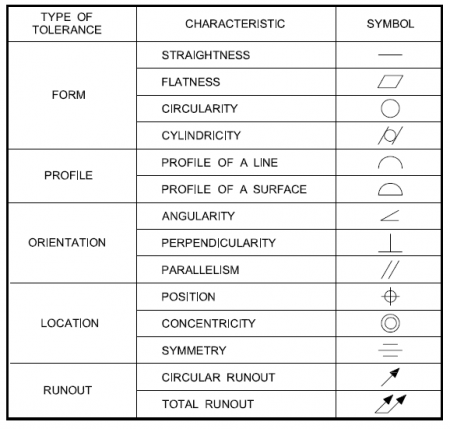ASME Y14.5規格を使用したGD&T注釈図
GD&TとはGeometric Dimensioning and Tolerancingの頭文字をとったもので、日本語では幾何公差と呼びます。幾何公差とは設計者が製造上の制約や公差を明確に伝えるために使用する記号言語です。この情報は、部品の設計に注釈として含まれ伝達されます。
まず始めに、設計者は幾何公差特有の規則を使用して、情報をモデルに追加します。これにより、これまで形状を説明するために使用されていた図面上の長い注釈が不要になります。幾何公差によって幅広い公差を設定することができ、設計者は部品の要件に基づいて寸法制約を柔軟に伝えることができます。
部品の検証時には、検査者がその幾何公差を解読し、部品の適合性、形状、機能に関する公差を確認します。
幾何公差を導入する目的は、利益の損失につながる混乱や不良品、手直しを防ぐことです。
幾何公差(GD&T)の種類

ASME Y14.5規格を使用した幾何公差のさまざまな種類、特性、および記号を示す図表
幾何公差は、不良の発生や手直しを防ぐためにどのように役立つのか?
明確な幾何公差を使えば、公差がより適切に定義されます。幾何公差は正確で機能的な定義を持っており、過剰な公差を必要としないため公差をより緩くすることができます。これは検査に合格できる部品が増えることを意味し、生産コストの削減を可能にします。
正確で機能的な定義により、検査員は、部品の位置合わせ方法、測定対象、および測定値の正しい計算方法を正確に知ることができます。十分に訓練された担当者が適切に使用することで、幾何公差は、設計部門と測定部門間の効率的なコミュニケーションを可能にし、誤判定を防止するのに役立ちます。
幾何公差(GD&T)を使う
幾何公差を使用して検査を行ったことがある方なら、幾何公差の使用にはいくつかの課題が伴うことをご存知でしょう。一般的な問題のひとつは、幾何公差が誤解されやすいことです。注釈や定義は理にかなっていますが、それらを適切に利用し解釈するには、設計者と検査者の双方にトレーニングが必要です。
幾何公差を効果的に活用するためのもう1つの課題は、公差が「セマンティック」である必要があることです。公差は、規格(ASMEまたはISO)によって設定された理論に準拠し、モデルに埋め込まれ、ジオメトリを直接参照する必要があります。設計ソフトウェアでは、セマンティック幾何公差を使用できる場合もありますが、強制することはありません。このため設計者は、公差がASME/ISOの論理に従っているかどうかにかかわらず、適切と思われる注釈を使用することができます。設計者がその意味を十分に理解していない場合、非セマンティック幾何公差は検査に問題を引き起こす可能性があります。このような場合、品質検査員は曖昧な公差を設計者の意図に合うように解釈し、検査が実行できるか判断することになります。公差を最初から適切に定義することで、このような無駄な時間の多くを節約することができます。
まとめ
幾何公差は、明確かつ簡潔に公差を符号化する方法です。適切に行われれば、製造工程の品質を向上させることができます。しかし、もし担当者が幾何公差の解釈や設定意図について訓練を受けていなければ、混乱や不良品、手直しを防止する効果は低くなり、これらはすべて利益の損失につながります。
